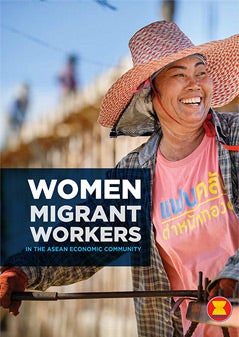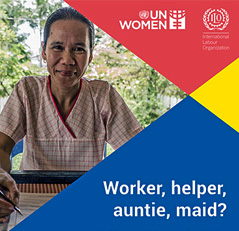Migrant Workers in the Asia-Pacific

Globalization, demographic changes and variations in supply and demand of labourers across countries contribute to the flow of migrant workers from origin to destination countries. Migration trends have been on the rise, particularly in the Asia and the Pacific region. Currently, the total stock of international migrants in the Association of Southeast Asian Nations (ASEAN) is 9.9 million; of those, nearly 6.9 million people have moved between countries within the region.[1]
Women and girls make substantive contributions towards the region's labour markets, production and remittance flows; women account for nearly half (48.7 per cent) of the intra-ASEAN migrant working–age population.[2]
The increase in demand for workers in highly feminized sectors (e.g. health care, domestic work, entertainment, manufacturing and textiles) in many destination countries (particularly Hong Kong, Malaysia and Singapore) results in an increased number of women migrant workers.[3] This, along with the lack of available full–time employment for men, leads to more women taking up work as migrant workers in feminized sectors in order to support their families and communities. At least 30 per cent of women migrant workers in Malaysia and Thailand are girls in the 15 to 24 year-old age group.

Despite the majority of women migrant workers having either a primary or intermediate level of education (87 per cent in Brunei Darussalam and 91 per cent in Malaysia), available data on migrant employment by occupation (not disaggregated by sex) confirms that migrant workers are largely concentrated at the bottom of the occupational skills ladder, i.e. in low- or medium-skilled manual labour.[4] Disaggregated labour shortage estimates from Thailand also suggest that a bulk of the labour shortage is in lesser–skilled professions that are largely women–dominated and attract vast inflows of women migrants into the country. In Thailand, domestic workers predominantly arrive from Cambodia, the Lao People's Democratic Republic and Myanmar. In Malaysia, women migrant domestic workers largely arrive from Cambodia, Indonesia and the Philippines.[5] Restrictive migration policies, weak contracts, lack of recognition and undervaluation of women migrant domestic workers results in them being exploited and devoid of rights (including social protections). Further, restrictive policies lead to an increase in the flow of undocumented domestic workers who are left more vulnerable to exploitation.
Addressing the issues faced by women migrant workers and their engagement in paid and unpaid domestic and care work is a priority area for UN Women (see CSW61). Ensuring gender equality, promoting sustained, inclusive economic growth and eradicating human trafficking of women domestic workers complies with the aims of Sustainable Development Goals 5, 8 and 10.
UN Women's work with women migrant workers – encompassing both origin and destination countries – draws upon international human rights standards. Working with governments, civil society and the private sector, UN Women focuses on promoting safe migration for women, eliminating human trafficking and enabling policy, institutional and socioeconomic environments that ensure women have equal opportunities and benefits from migration. Specific programme support includes establishing laws and practices that protect women migrant workers' human rights, strengthening migrant workers' organizations and brokering exchanges between source and destination countries in order to advance labour rights.
- UN Women, Asia and Pacific Regional Office, Women Migrant Workers in the ASEAN Economic Community (Bangkok, 2017).
- UN Women, Asia and Pacific Regional Office, Women Migrant Workers in the ASEAN Economic Community (Bangkok, 2017).
- UN Women, East and Southeast Asia Regional Office, Gender, Migration and Development- Emerging Trends and Issues in East and South-East Asia (Bangkok, 2011).
- UN Women, Asia and Pacific Regional Office, Women Migrant Workers in the ASEAN Economic Community (Bangkok, 2017).
- International Labour Organization; ILO Regional Office for Asia and the Pacific, Worker, Helper, Auntie, Maid?: Working Conditions and Attitudes Experienced by Migrant Domestic Workers in Thailand and Malaysia (ILO: 2017).
Related news
Featured Publication

Women Migrant Workers in the Asean Economic Community
Free movement of skilled labour, which takes into account relevant domestic regulations and market demand conditions, is a key component of this regional economic integration agenda. ASEAN main destination countries... Read more
Featured Infographics

Will women workers fully benefit from increasing job opportunities and mobility in Southeast Asia?
Infographics explain the current situations of migrant workers and the governance frameworks at national and regional level, providing actionable evidence-based policy recommendations to benefit from women’s labour mobility, provide fair and equitable migration opportunities for women, and enhance regional social and economic development... Read more
